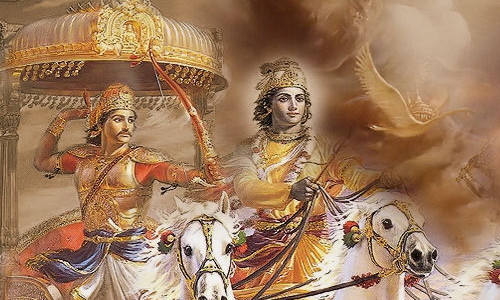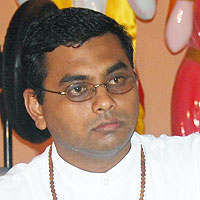The Bhagavad Gita was compiled by Sage Ved Vyaas over 5,000 years ago on Mokshadaa Ekadaasi in the month of Maarghsheersh (November-December). Shrimad Bhagavad Gita literally means ‘Divine Song of God’ and is derived from one of the world’s longest epics, the Mahaabhaarat. It can be found in the Bhishma Parva of this epic and details the conversation between Bhagavan Shri Krishna and the Paandav prince, Arjuna on the battlefield of Kurukshetra at the commencement of the war between the Paandavas and the Kauravas.
As the warriors of the Paandav and Kaurav armies were arrayed for battle, Arjuna became faint-hearted and refused to fight. Bhagavan Shri Krishna, Arjuna’s charioteer, delivered various divine teachings, convincing Arjuna that it was his duty to defend his army and uphold righteousness. Sanjay, through a divine vision conferred upon him by Ved Vyaas, described to the blind king Dhritarastra all that was taking place on the battlefield. This dialogue between the Lord and Arjuna, as narrated by Sanjay, comprises the Gita.
This divine discourse, written in Sanskrit, comprises 18 chapters and 700 shlokas (verses) and contains profound truths from Bhagavan Shri Krishna. The battle between the two powerful armies is considered a metaphor of the inner battle to conquer the negative forces opposing human’s ultimate goal of reaching the Supreme Lord. The practices that lead one to self-realisation, bhakti (devotion), karma (action) and gyaan (knowledge) yoga, are explained at great length.
In the last chapter (chapter 18, verse 65), the Lord urges humans to acquire the qualities of Bhagavan in order to achieve self-realisation: “Give your mind to Me, be devoted to Me, worship Me and bow down to Me. Doing so, you will come to Me alone, I truly promise you, for you are exceptionally dear to Me.” The self-realised person is one whose entire life is devoted to God, and who inspires others by benevolence, purity of intent of actions, empathy and strength of character. Such an individual stimulates right action, encouraging personal uplift in others. They create the spark of improvement, devotion to duty and the pursuit of a dharmic lifestyle.
One of the practices emphasised throughout the text is the necessity of performing one’s duties. This is expressed quite clearly at the beginning of the very first chapter: “Dharma-kshetra kurukshetra”, the field of activity is the field of one’s duty. Later on, in chapter three, Bhagavan informs that whoever does not perform his duty is sinful, while the individual who performs his actions without attachment attains the Supreme.
Some other subjects discussed in depth are: the nature of the soul, the sattvic (pious), rajasic (materialistic) and tamasic (sluggish) characteristics, the importance of selfless action, devotion to the form and formless God and the different forms of sacrifices, among others.
An in-depth study of this scripture can lead to some of the most profound truths and an experience of the all-pervasive God. We should resolve to strengthen our practice of Rishi Yagya by engaging ourselves in daily study of the Gita. Chapter 18, verse 70 states, “Whosoever studies this sacred dialogue of ours in the form of the Gita, by him too shall I be worshipped with Yajna of Knowledge; such is My word. The person who listens to the holy Gita with reverence, being free from malice, he too, liberated from sin, shall reach the propitious worlds of the virtuous.”



